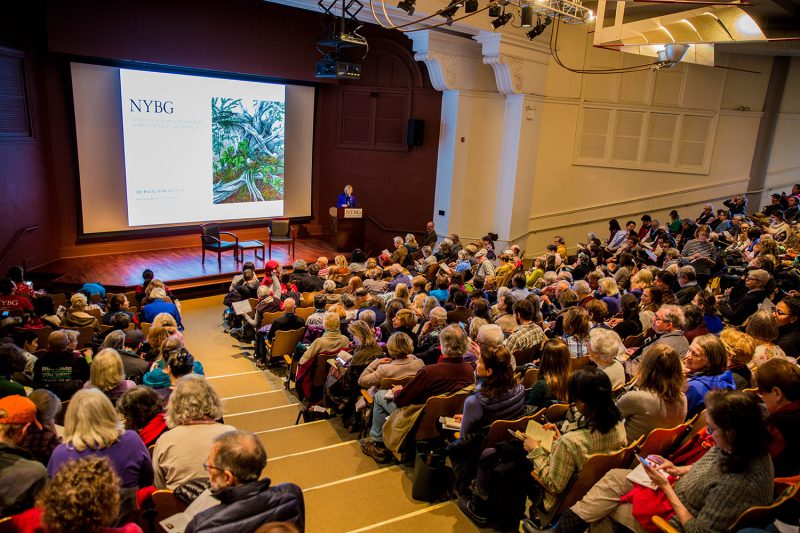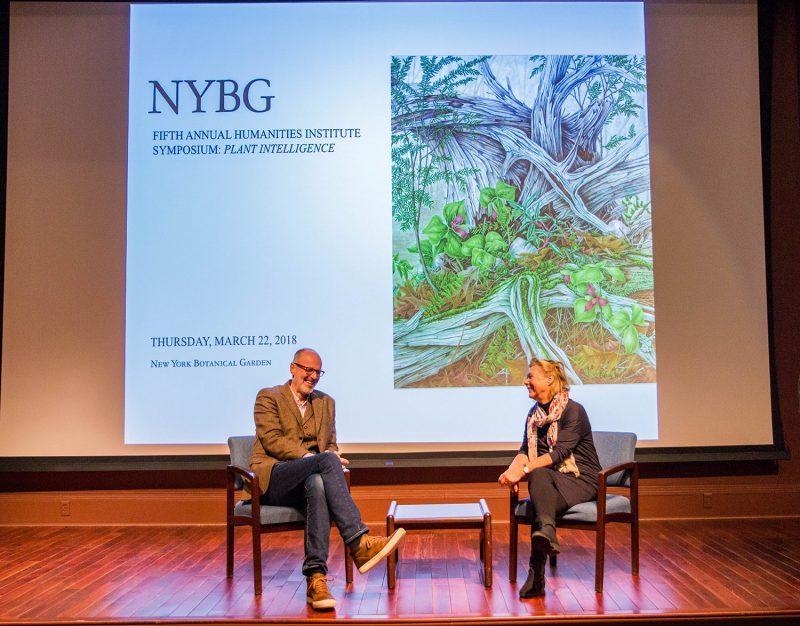Fifth Annual Humanities Institute Symposium: Plant Intelligence
Posted in Humanities Institute on June 13 2018, by Vanessa Sellers

This year’s Humanities Institute Symposium again brought together a large body of students, scholars, horticulturists, foresters, environmental specialists, tree-lovers, and other researchers and professionals to explore a topic vital to this day and age. While last year’s symposium looked at the challenge of climate change, this year’s symposium, Plant Intelligence, was focused on an equally challenging question: Do plants have intelligence? Using the latest biological evidence, several renowned scientists explored this key question by sharing new discoveries in forest and lab, offering new insights into the inner life of plants. Their findings—including astonishing examples of plant signaling and information processing—challenged the audience’s common perception of plants and presented new paradigms for the understanding of nature.
It was the second day of spring, but a thick layer of snow had changed the Garden overnight into a veritable winter wonderland. Warned for the winter storm, Janet Brown, the main moderator, and Peter Wohlleben, well-known German forest manager, had managed to arrive in New York City a day early. To everyone’s regret, the second speaker, Stefano Mancuso, Director of the International Laboratory of Plant Neurobiology in Florence, was stuck in Europe and unable to join the proceedings at the very last moment. Despite the deep layer of snow, a full house of close to 400 people filled Ross Hall to take part in the conversation.
After a welcome word by Dr. Vanessa Sellers, the Humanities Institute’s host, Dr. Janet Browne took the stage and provided an excellent introduction on the history of thinking about plant sensitivity. Pointing out wrong definitions and misconceptions about plants (as unmoving, non-responsive organisms) through the ages, she remarked: “from Aristotle’s time onwards, with a few notable exceptions, it has been common to describe plants as though they are completely different from animals, and it is often said in justification that plants lack the ability to move and are not able to think. This is unjust to plants.” Browne explained that it wasn’t until the 18th century that the responsive movement of plants was recognized, and not until the later 19th century that Darwin elevated plants in the scale of nature, by pointing out their adaptive resourcefulness. “Much remains to be done,” said Browne, calling Wohlleben to the stage: “We are here today to learn about the important new frontier in understanding plant activity.”

Using carefully selected images and offering explanations filled with humor, Wohlleben shared intriguing new findings about the forest’s hidden forces, highlighting themes discussed in his groundbreaking book, The Hidden Life of Trees, What They Feel, How They Communicate – Discoveries from a Secret World. He gave examples of the extraordinary inner life of trees and plants, explaining how they build close connections and communications systems. His presentation was followed by a panel discussion and questions from the audience. One audience member asked: “How close are we to assigning consciousness to plants and trees?” Another participant wondered: “If we don’t want to use anthropomorphic terminology, what kind of words should we use to define plants’ amazing sensory abilities exactly?” While the key question of precise, scientific terminology needs to be further resolved, Wohlleben responded with the following: “What have trees taught you personally?” He pointed at the different time scale of the life of trees (300 years to early adulthood) in comparison to that of a human life. Trees’ slow pace of activity is a challenge for scientific research—only future generations will know the results. “With plants and a forest, you have to think in terms of centuries. I learned to accept that I can’t do everything as a forester.” But to the question, “Would you advise governments not to log recklessly?” Wohlleben simply answered: “Of course.”

The morning’s discussion certainly left much to think about, awakening in everyone a renewed sense of awe for plants and nature. The discussions incorporated some of Stefano Mancuso’s findings on plant memory systems as well, as described in Brilliant Green (2015), and further explored in his forthcoming book, The Revolutionary Genius of Plants, which promises to make a compelling scientific case for the notion that plants are intelligent problem solvers.
“The message for today,” Janet Browne remarked, summarizing the morning’s proceedings, “is that we all should begin to treat plants as protagonists in their own lives, highly skilled in responding to their environments and intervening in nature.” We look forward to continuing the conversation about Plant Intelligence in the future.

